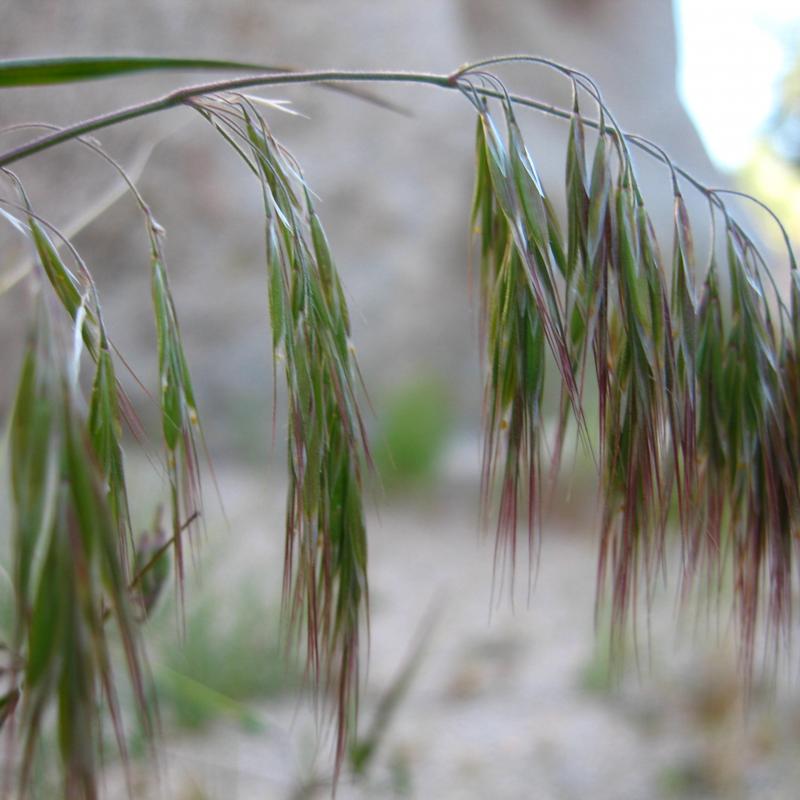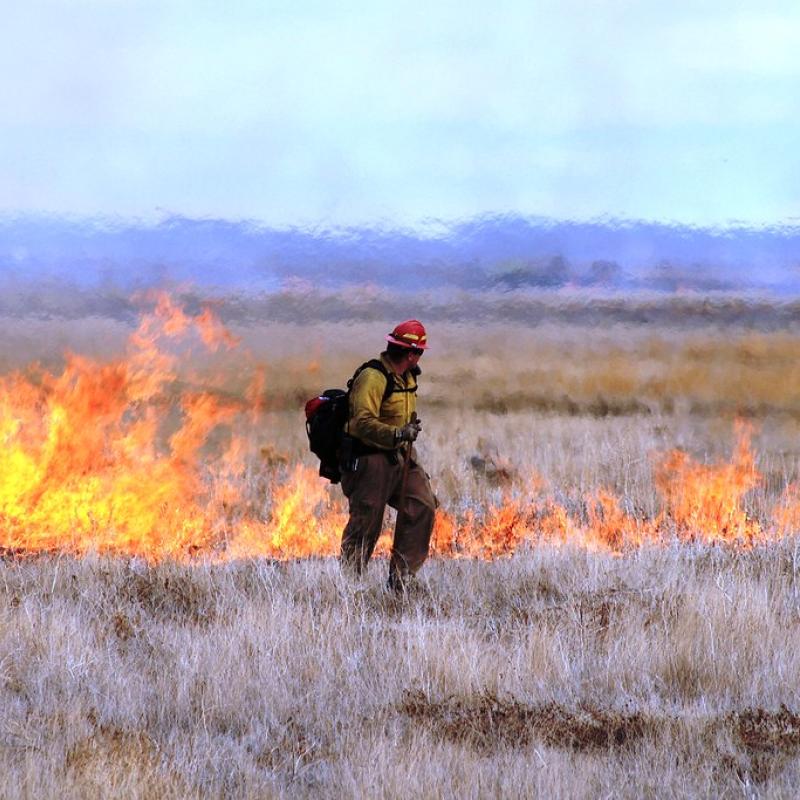Cheatgrass vs. Sagebrush
Consequences of Invasion and Fire on Carbon Storage
Globally, many ecosystems are transitioning from one form to another as a result of human activities such as introduction of invasive species, land use change, climate change, and management practices. Some areas, such as the western United States, are experiencing an increase in woody plants (Knapp et al. 2008) while other areas, such as the Southern Amazon or the Great Basin are transitioning to grasslands (Hoffman et al. 2004; Chambers and Wisdom 2009). As ecosystem functions and services are derived from the types of species present in a system and their interactions, these changes in vegetation types may also impact ecosystem functions. Carbon storage is one of these services, and is of particular concern due to carbon’s role in climate change -- increasing carbon storage in ecosystems could be a valuable approach to reducing carbon in the atmosphere, and therefore mitigating climate change. In order for us to better manage carbon storage in ecosystems, it is important that research identify how changes in vegetation types affect ecosystem functions and services, and therefore how prone to change these systems are in the face of human activities.

This study, done in collaboration with colleagues at the University of Massachusetts and Mount Holyoke College, looked at cheatgrass invasion in the Great Basin. Cheatgrass (Bromus tectorum) is likely the most successful plant invader in North America and the extent of cheatgrass invasion across this region is significant (~210,000 square kilometers, or 81,000 square miles -- larger than the state of Nebraska; Chambers et al. 2007, Bradley et al. 2018). Cheatgrass is replacing native sagebrush, and has been shown to change many aspects of ecosystem structure and function (Germino et al. 2016; Ehrenfeld 2010). Cheatgrass is also one of the best known examples of a species that promotes a “grass-fire cycle”, in which invasion both increases the chances of fire in an area and further spreads the grass after a fire occurs, leading to what ecologists call a positive feedback loop (D’Antonio and Vitousek 1992; Brooks et al. 2004). The combination of the grass-fire cycle and the loss of woody plants suggest that less carbon is stored in cheatgrass-dominated ecosystems than sagebrush systems.

Methods and Results
Figure 1: Map of study locations by carbon (C) pool: (A) above-ground biomass (AGB) C, (B) below-ground biomass, (C) soil organic C (SOC), (D) total soil C, and (E) litter C. Panel (F) shows the Great Basin ecoregion of the western United States, outlined in grey
To test this theory, we conducted a literature review of other related studies. For scientists, a literature review is a useful tool to collect and synthesize other research that has already been completed in order to draw out the common themes and come to new conclusions with more data. In this case, we systematically searched for studies that reported on biomass dry weight, carbon content, or carbon concentration for the carbon pools we were interested in (aboveground biomass, belowground biomass, litter, soil organic carbon, total soil carbon). These are the five main pools where carbon is stored in ecosystems and include the live plants, dead plant matter, and soils. After conducting our search, we classified each article’s studied ecosystem as “sagebrush” (indicating no cheatgrass), “invaded sagebrush” (indicating that some cheatgrass was present along with sagebrush), and “cheatgrass” (indicating cheatgrass was the dominant or only species present). Since we expected fire to influence carbon storage, we used the time since the most recent fire as a way to help explain the carbon storage results. We used a statistical method called linear mixed models to tell us which factors were most important for carbon storage.
Figure 2: Mean and standard error (SE) carbon content (g C/m2) by vegetation type for (A) above-ground biomass (AGB), below-ground biomass (BGB) and litter, (B) organic soil by soil depth (0–10 and 10–20 cm), (C) organic soil C by soil depth in deeper soils (on a per cm basis) and (D) total soil from 0 to 10 cm
In total, we analyzed 41 different studies. Our results showed widespread loss of biomass-related carbon, gains in litter-based carbon, and nuanced changes in soil carbon related to soil depth and time since fire. Consistently, cheatgrass-dominated sites had less biomass carbon than sagebrush sites (55% lower above-ground, and 62% lower below-ground). The reduction of above-ground biomass is the result of losing woody shrubs to shorter grasses, and the shorter, thinner roots of cheatgrass (as compared to sagebrush) explains the reduction in below-ground biomass. Increases in soil organic carbon were found near the surface of the soil (top layers) but losses are possible lower in the soil.
We hypothesized that fire would have a strong influence on carbon storage. Fire removes carbon from ecosystems as organic matter burns (both the plants themselves and on the surface of the soil). We found that all carbon pools were related to time since the most recent fire. Initial increases in above-ground biomass as cheatgrass grows in between sagebrush plants are lost after fire occurs and cheatgrass replaces sagebrush as the dominant plant. Also, while this study did not test for this, multiple fires in the same place can lead to greater carbon losses. Thus, cheatgrass removal (or sagebrush restoration) and wildfire may need to be managed together to preserve carbon storage in these ecosystems.

The Importance of Management
Our study provides the most comprehensive review to date of the effects of cheatgrass invasion on carbon storage in sagebrush ecosystems. However, knowledge is only part of the solution - management practices are critical for maintaining ecosystem functions and promoting ecological resilience. In the face of climate change and other ecological challenges, managers currently have three options - Resist (restore or maintain native systems), Accept (allow changes to occur), or Direct (manage inevitable change to produce desirable outcomes) (Schuurman et al. 2020). Some management practices particularly relevant for cheatgrass include targeted grazing, cheatgrass removal, restoration of native species such as sagebrush, and creating breaks in plants that keep fire from crossing (i.e., fuel breaks)(USDA 2014, UWY and CSU 2013). These actions may increase the resilience of native vegetation to future disturbances, reduce the likelihood of severe fires, store more carbon, and reduce costs of invasive species to the economy and human health (Porensky et al. 2018). The United States spends $8 billion/year managing terrestrial invasive plant species (Pimentel et al. 2005) and $2–3 billion/year on fire suppression (Gorte 2013; NIFC 2019). Programs such as carbon markets that provide incentives for ecologically desirable outcomes could offset costs of cheatgrass removal and fire suppression (Meyer 2012). These management and public policy actions, which promote the restoration of native vegetation, are among some of the most promising options for carbon storage and mitigating climate change.




